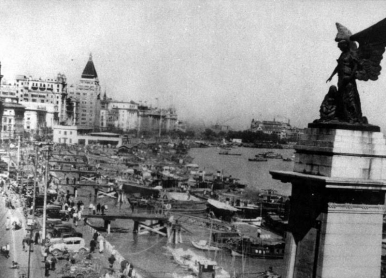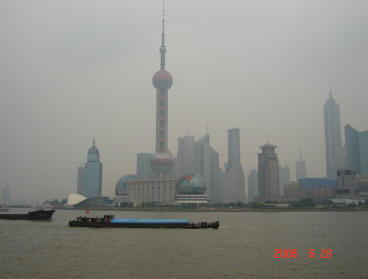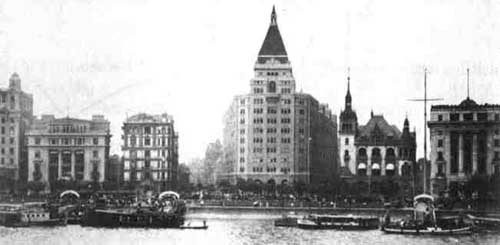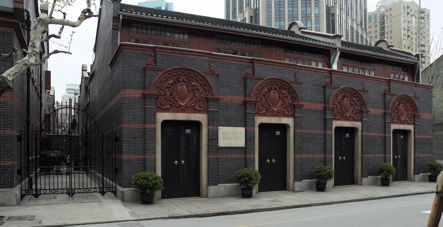

1933 The Bund (International Settlement) 2006 Pudong - The Pearl Tower across the Huangpu River
Stop 1: Shanghai "Paris of the East"


1933 The Bund (International Settlement)
2006 Pudong - The Pearl Tower across the Huangpu River
Stop 1: Shanghai "Paris of the East"
Focus Question:
How has
Shanghai's geography affected its history, its current growth and its importance?
Portfolio Questions:
Why do people live and move where they do? & How has the quest for resources
affected human history?
Geography: Shanghai
is located on the eastern coast of China. It lies in the Yangtze River delta,
where the waters of China's longest river drains into the East China Sea. The
city is divided into two parts: Puxi (west of the Huangpu River) and Pudong
(east of the Huangpu River).
 Tourist Map
Tourist Map
 Shanghai Satellite Picture
Shanghai Satellite Picture
 Shanghai Map 1904
Shanghai Map 1904
History:
Introduction: Shanghai means, "By the sea." Unlike
many cities in China with long and varied histories, Shanghai's history is quite
short. The British opened a concession in Shanghai after the first
Opium War and
ignited Shanghai's evolution. Once a small fishing village on the edge of the
muddy Huang Pu River, it has become one of the world's most modern and
sophisticated cities.
1842: The British establish a concession by forced treaty with the Qing Dynasty after China loses the first Opium War. Concessions were governed by the occupying country and were untouchable by Chinese law. The French, Americans and Japanese soon followed the British in establishing territories in Shanghai.
 1880
- The Bund in Shanghai
1880
- The Bund in Shanghai
1930s: Shanghai has since become the most important port in Asia and the world's largest trading and banking firms have set up house along the Bund. Tea, silk and porcelain sail to Europe and America and opium comes in to pay for it. Shanghai is the most modern city in Asia - the Astor House Hotel has the first electric light bulb – but also the most licentious as opium dens, brothels and the ease of escaping the law abound. No visas or passports are required at the port and Shanghai soon becomes infamous as an exotic port of call.
 The Peace Hotel at Nanjing Street in the 1930's.
The Peace Hotel at Nanjing Street in the 1930's.
1931-1941: Shanghai becomes a haven for Jews fleeing Nazi terror. As other countries closed their doors to immigrants in the lead up to the Second World War, over 20,000 Jewish refugees found asylum in Shanghai.
1937: Japanese bombs hit Shanghai and the foreigners evacuate en masse. Japanese control Shanghai and much of China's eastern coast until their defeat at the hands of the Allied Powers in 1945.
1943: The Allied governments abandon Shanghai during the War and sign their territories over to Chiang Kai-Shek and the Kuomintang government. The foreign concession era officially ends.
1949: Most foreigners have left Shanghai and the Chinese Communist state takes control of the city and the formerly privately-held businesses. Industry suffers until 1976 under the Cultural Revolution (1966-76) as hundreds of thousands of Shanghainese locals are sent to work in rural areas throughout China.
 1921 The Chinese Communist Party held its first
meeting in this building in Shanghai.
1921 The Chinese Communist Party held its first
meeting in this building in Shanghai.
1976: The
advent of Deng Xiaopeng's
open door policy allowed a commercial revival to take place in Shanghai.
[Source:
About.com - A Short History of Shanghai]
 Shanghai Skyline
Shanghai Skyline

 Unique
Architecture
Unique
Architecture
![]() Ongoing Construction
Ongoing Construction
Today: Shanghai is growing into one of the most cosmopolitan cities in Asia with increasingly modern infrastructure and services. It's port is ranked number #1 in the world for the amount of cargo that is shipped to and from worldly destinations (Financial Express). Shanghai is China's second largest city (after Chongqing) with a population of over 17 million. Dynamic and innovative, Shanghai is helping to drive China's developing economy. By 2004, more than 5,000 new buildings over 15 stories tall were built. "Today, the Pudong district is home to nearly six thousand foreign-funded businesses, including the offices of nearly three hundred of the Global Fortune 500 companies..." (China Inc.)
Related Assignment: Silk Road: Examining Foreign Influences on Chinese Culture
Photo
Galleries:
Shanghai Architecture
Jing'an
Park
Buddhist
Temple
The Pearl
Tower
People, Streets, Etc...
Yu Garden
More Websites for
Information:
Shanghai Live Webcams & Video
Shanghai Museum (Includes virtual tours)
Shanghai Urban Development: The Future Is Now (NPR 2006)